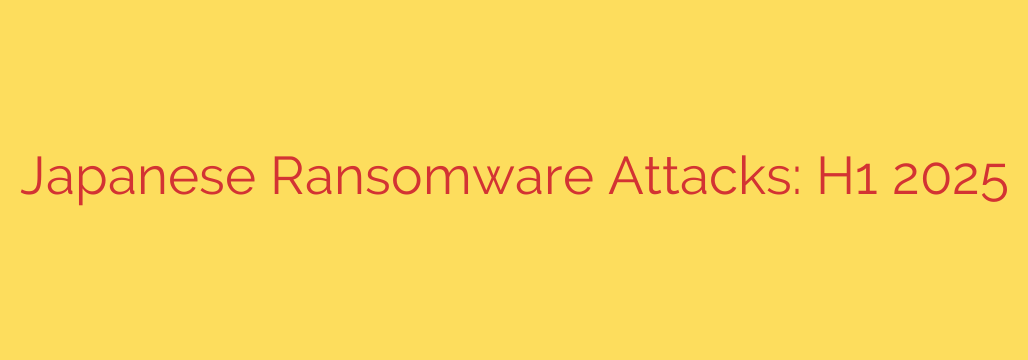
Japan Faces Alarming Surge in Ransomware Attacks: Key Trends and Defenses for 2025
The first half of 2025 has revealed a troubling escalation in ransomware attacks targeting Japanese organizations, with cybercriminals employing more aggressive tactics and causing unprecedented disruption. The threat is no longer a distant possibility but a clear and present danger to businesses of all sizes across the nation. Understanding the current landscape is the first step toward building a resilient defense.
A comprehensive analysis of recent cyber incidents shows a significant spike in attacks, marking one of the most active periods for ransomware gangs in the region. These criminals are not just encrypting data; they are increasingly engaging in “double extortion,” where they steal sensitive corporate information before locking systems and threatening to leak the stolen data publicly if the ransom is not paid.
Key Ransomware Trends Emerging in 2025
The latest wave of attacks is characterized by several distinct patterns that organizations must recognize to effectively mitigate risk.
- A Sharp Increase in Reported Incidents: Compared to the same period last year, reported ransomware attacks have surged dramatically, indicating a more hostile digital environment. This increase is driven by the accessibility of Ransomware-as-a-Service (RaaS) platforms, which lower the barrier to entry for less skilled cybercriminals.
- Manufacturing and Healthcare are Prime Targets: While no industry is immune, the manufacturing and healthcare sectors have been disproportionately affected. These industries are attractive targets due to their critical reliance on operational technology (OT) and their possession of valuable intellectual property and sensitive patient data. Disruption in these sectors can halt production lines or compromise patient care, increasing the pressure on victims to pay the ransom quickly.
- Exploitation of Known Vulnerabilities: Attackers continue to rely on proven methods of infiltration. The primary entry points remain unpatched software vulnerabilities, compromised credentials obtained through phishing, and poorly secured remote access points like RDP. This highlights that many successful attacks are preventable with fundamental cybersecurity hygiene.
- Focus on Small and Medium-Sized Businesses (SMBs): Contrary to the belief that cybercriminals only target large corporations, SMBs are increasingly in the crosshairs. Often perceived as having weaker security defenses and fewer resources for cybersecurity, they represent an easier and highly profitable target for ransomware groups.
Actionable Steps to Defend Your Organization
The growing sophistication of these threats demands a proactive and multi-layered security strategy. Waiting to respond after an attack is no longer a viable option. Here are essential steps every organization should implement immediately to strengthen its defenses against ransomware.
Implement a Robust Backup and Recovery Strategy: This is your most critical defense. Regularly back up all critical data using the 3-2-1 rule (three copies of your data, on two different media types, with one copy stored off-site and offline). Crucially, test your backups frequently to ensure you can restore operations quickly and effectively after an incident.
Enforce Multi-Factor Authentication (MFA): Stolen credentials are a leading cause of security breaches. Enable MFA on all critical accounts and services, including email, VPN access, and administrative accounts. This simple step adds a powerful layer of security that can block an attack even if a password is compromised.
Prioritize Patch Management: Cybercriminals are experts at scanning for and exploiting known vulnerabilities in software and systems. Establish a rigorous patch management process to ensure all operating systems, applications, and network devices are updated promptly. Prioritize patching for critical and internet-facing systems.
Conduct Continuous Employee Security Training: Your employees are your first line of defense. Invest in ongoing training programs that teach them how to recognize and report phishing attempts, use strong passwords, and understand their role in protecting company data. A security-aware culture is a powerful deterrent.
Develop and Practice an Incident Response Plan: Don’t wait for a crisis to figure out what to do. Create a detailed incident response plan that outlines the specific steps to take during and after a ransomware attack. This plan should include roles and responsibilities, communication protocols, and procedures for containment, eradication, and recovery. Practice this plan through tabletop exercises to ensure your team is prepared.
The threat of ransomware in Japan is evolving and intensifying. By understanding the tactics used by attackers and implementing these essential defensive measures, organizations can significantly reduce their risk and build the resilience needed to operate safely in today’s challenging digital landscape.
Source: https://blog.talosintelligence.com/ransomware_incidents_in_japan_during_the_first_half_of_2025/








